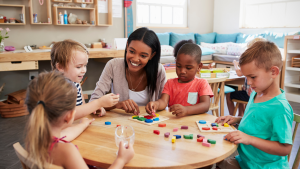Creativity is an essential skill that fuels innovation, problem-solving, and the ability to think outside the box. Grade R marks a significant stage in a child’s educational journey, where foundational skills are established; encouraging creativity during this period can have a lasting impact on a child’s cognitive, social, and emotional growth. This blog explores various techniques for fostering creativity in Grade R learners — with a particular focus on the South African context.
Understanding the importance of creativity in early childhood
Creativity is not just about artistic expression; it encompasses the ability to generate new ideas, approach problems from different angles, and adapt to changing situations. For Grade R learners, creativity plays a vital role in:
- Cognitive development: Encouraging creative thinking helps children develop critical thinking skills, improve their memory, and enhance their ability to make connections between different concepts.
- Social development: Creative activities often involve collaboration, which helps children learn how to work with others, share ideas and appreciate different perspectives.
- Emotional development: Creativity allows children to express their feelings, build self-confidence, and develop a sense of identity.
In South Africa, where the educational system aims to produce well-rounded individuals who can contribute meaningfully to society, fostering creativity in young learners is essential.
Techniques for encouraging creative thinking in Grade R learners
1. Incorporate play-based learning
Play is a natural way for children to explore their world and it provides numerous opportunities for creative expression. Play-based learning involves using play as a medium for teaching various concepts and skills. In a Grade R classroom, this could include:
- Role-playing: Setting up role-playing scenarios where children can act out different roles, such as a Shopkeeper, Doctor, or Teacher; this encourages them to use their imagination and think creatively about different situations.
- Building and construction: Providing building blocks, LEGOs, or other construction materials allows children to create structures, solve problems, and experiment with different designs.
2. Encourage artistic expression
Art is one of the most direct ways to foster creativity in young learners; providing opportunities for children to engage in various forms of artistic expression can help them develop their creative thinking skills. Techniques include:
- Free drawing and painting: Allow children to draw or paint whatever they like without strict guidelines; this encourages them to think independently and express their unique ideas.
- Craft activities: Simple crafts like making collages, using clay, or creating sculptures from recycled materials can stimulate creativity. Encourage children to think about different ways to use materials and create something new.
3. Use open-ended questions
Asking open-ended questions is a powerful way to stimulate creative thinking; unlike closed questions, which have a single correct answer, open-ended questions encourage children to think more deeply and come up with multiple solutions. Examples of open-ended questions in a Grade R setting include:
- “What do you think would happen if we mixed these two colours?”
- “How do you think we could build a house for our toy animals?”
- “What story can you make up about this picture?”
4. Create a stimulating environment
The classroom environment plays a significant role in fostering creativity. A stimulating and inviting environment can inspire children to explore, create, and imagine. To create such an environment in a Grade R classroom, consider:
- Display children’s work: Showcase children’s artwork, crafts, and projects around the classroom. This not only boosts their confidence but also inspires them and their peers to be more creative.
- Provide diverse materials: Have a variety of materials available for creative activities, such as different types of paper, fabric, beads, and natural objects like leaves and stones.
- Create themed learning corners: Set up different areas in the classroom dedicated to specific themes, such as a reading corner, an art station, or a science exploration table; these themed corners can spark children’s curiosity and creativity.
5. Encourage storytelling and imaginative play
Storytelling is a powerful tool for developing creative thinking; it encourages children to use their imagination, create narratives, and explore different characters and scenarios. In Grade R, you can encourage storytelling through:
- Picture books: Use picture books as a starting point for children to create their own stories; ask them what they think happens next or how they would change the ending.
- Puppetry: Provide puppets or simple props and let children create their own puppet shows. This encourages them to think creatively about dialogue, characters, and plots.
The role of Teachers and parents in fostering creativity
Teachers and parents play a crucial role in nurturing creativity in young learners. In the South African context, where education is increasingly focused on developing well-rounded individuals, fostering creativity is particularly important. Here are some ways that Teachers and parents can support this process:
- Encourage risk-taking: Allow children to take risks and make mistakes in their creative endeavours, this helps them learn that creativity often involves trial and error.
- Provide positive reinforcement: Celebrate children’s creative efforts, regardless of the outcome; positive reinforcement boosts their confidence and encourages them to keep exploring their creativity.
- Model creative behaviour: Teachers and parents can model creative behaviour by engaging in creative activities themselves, this could involve drawing, painting, storytelling or playing music with children.
Nurturing the creative minds of tomorrow
Fostering creativity in Grade R learners is essential for their overall development and success in the future. By incorporating play-based learning, artistic expression, open-ended questions into the classroom, Educators can create an environment where creativity thrives. In South Africa, where education is a key driver of social and economic progress, nurturing creativity in young learners is more important than ever. By encouraging creative thinking in Grade R, we are not only shaping the minds of tomorrow but also laying the foundation for a more innovative and prosperous society.
Creativity is the spark that ignites a lifelong love of learning; let’s empower our Grade R learners to explore, imagine, and create with confidence. Step into a rewarding career where you shape the future of our youngest learners by fostering creativity, critical thinking, and a love for learning from day one. As a Grade R Teacher, you will play a crucial role in early childhood education, laying the foundation for lifelong success. Unlock the potential of young minds with Lyceum’s Diploma in Grade R Teaching programme.



